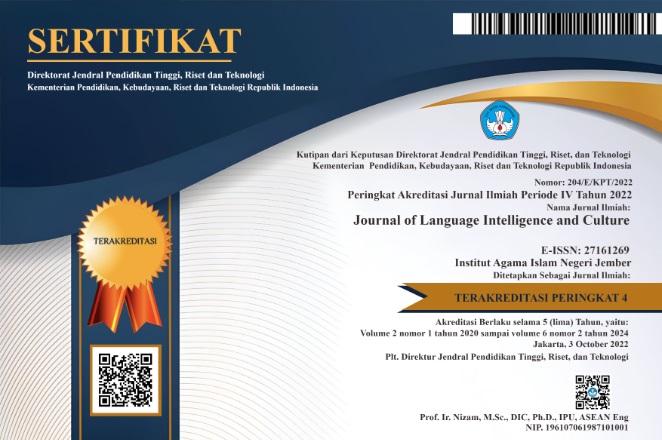Questioning the Language: A Review on Its Origin, Linguistics, and the Teaching of Language
DOI:
https://doi.org/10.35719/jlic.v4i2.111Keywords:
Origin of language, concept of linguistics and applied linguistics, teaching of languageAbstract
This study aims to identify the language origin, linguistics, applied linguistics, the teaching of language ang the testing language. These scopes within the language serve a significant role in the language studies. Employing library research type, the data were collected through some books and article journals related to the topic of interests. Related to the origin of the language, some theories have been proposed that there is an innate capacity or some sort of mental device formed within human’s mind which responsible for the production of language. For such matter, the study of language, known as Linguistics, has been vastly developed to discuss and explain how language and its aspects work within the interactions done by humans in daily basis. The complexity of the language itself and its effect within human interaction serves one the most important aspects in the teaching of language and testing of language.
References
Bagari?, V. & Djigunovi?, J. M. (2007). Defining Communicative Competence. Metodika. 8: 94-103.
Brown, H. Douglas. (2004). Language Assessment: Principles and Classroom Practices. London: Pearson Longman.
Dobrovolsky, M. (2005). Phonetics: The Sounds of Language. In William O’Grady and John Archibald (editors). Contemporary Linguistics: An Introduction. New York: Bedford.
Grabe, W. (2002). Applied linguistics: an emerging discipline for the twentieth century. In Robert B. Kaplan (Ed.), Oxford handbook of Applied Linguistics. New York: Oxford University Press.
Harmer, J. (2007) How to Teach English. London: Pearson Education Limited.
Higgins, E. C. & Dobrovolsky, M. (2005). Phonology: The Function and Patterning of Sounds. In William O’Grady and John Archibald (editors). Contemporary Linguistics: An Introduction. New York: Bedford.
Hughes, A. (2003). Testing For Language Teachers. Cambridge: Cambridge University Press.
Louma, S. (2009). Assessing Speaking. New York: Cambridge University Press.
McCarthy, M. (2001). Issues in Applied Linguistics. Cambridge: Cambridge University Press.
Richards, J. C. (2008). Teaching Listening and Speaking. Cambridge: Cambridge University Press.
Schmitt, N. & Celce-Murcia, M. (2002). An overview of applied linguistics. In Schmitt, Norbert. (ed.), An Introduction to Applied Linguistics. London: Hodder Education.
Stern, H. H. (1983). Fundamental Concepts of Language Teaching. London: Oxford University Press.
Strevens, P. (1992). Applied Linguistics: An Overview. In William Grabe and Robert B. Kaplan (editors). Introduction to Applied Linguistics. New York: Addison-Wesley Publishing Company.
Sulistyo, G. (2015). H. EFL Learning Assessment at Schools. Malang: CV Bintang Sejahtera.
Yule, G. (2010). (eds). The Study of Language. Cambridge: Cambridge University Press.
Downloads
Published
How to Cite
Issue
Section
License
Copyright (c) 2022 Wildatul Hasanah

This work is licensed under a Creative Commons Attribution-ShareAlike 4.0 International License.













